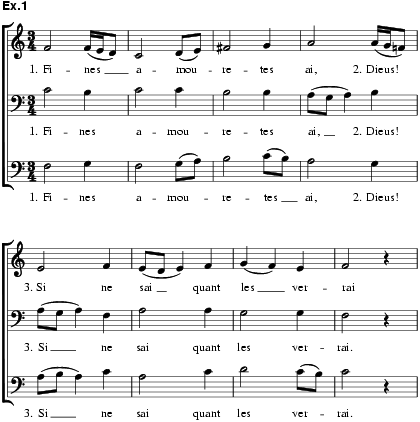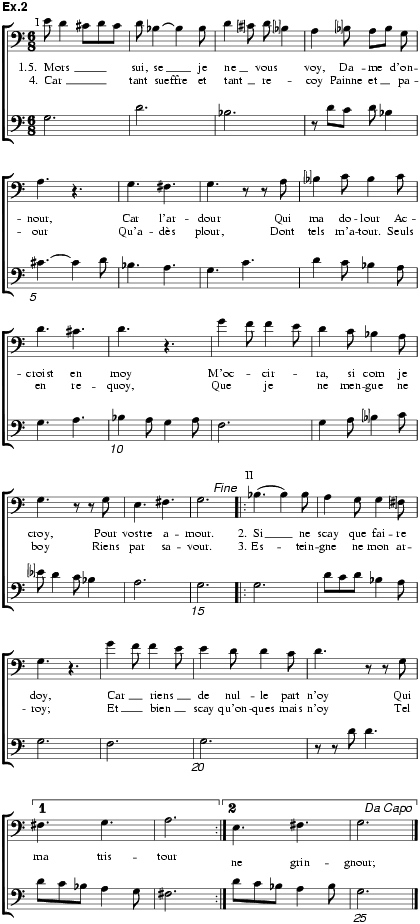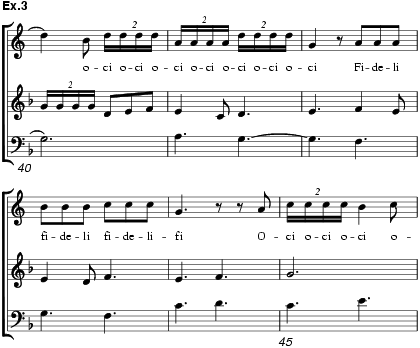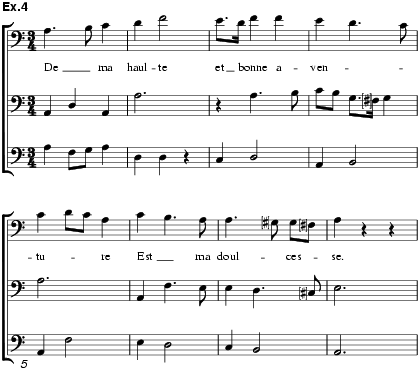
One of the three formes fixes (the others are the ballade and the rondeau) that dominated French song and poetry in the 14th and 15th centuries. Its musical structure is essentially ABBA, regardless of subtleties of rhythm and metre in the superimposed text. The virelai form has a long and complex history, closely interwoven with the general history of early song and dance.
Convincing studies suggest a line of descent from 11th-century Arabic song forms in north Africa and Spain, the mūwashshah–zajal types. They would in turn have influenced Provençal troubadour song structures and by the 12th century also Old French song forms further north. These would then have persisted in France and also have been a dominant influence on the compositions in the large late 13th-century Spanish religious song collection compiled at the request of King Alfonso el Sabio (1221–84) and known as the Cantigas de Santa María. These are nearly all virelai types; and this song pattern evidently became extremely popular in both Spain and Portugal, for many examples have survived which have usually been described since the 15th century by the term ‘villancico’.
A second major school of thought prefers to see any similarities between Arabic and Romance song forms as mere coincidence. It suggests, equally convincingly, that the main source of virelai form and, indeed, of Provençal courtly song in general, is to be found in poetic and musical patterns contained in the liturgical repertory, particularly in such influential centres as the monastery of St Martial, Limoges. The whole complicated Arabic–liturgical debate, unlikely ever to find a total solution, is lucidly summed up by P. Le Gentil in his book Le virelai et le villancico (1954).
The root of the word ‘virelai’ is Old French virer (‘to turn’ or ‘to twist’). This confirms the dance origins of the form at least for France, where in the 13th century ‘vireli’ is the most common spelling; ‘virelai’ was a modification probably under the influence of another important musical and poetic form, the lai.
In the 13th century approximations to virelai form may occasionally be found in one or more voices of polyphonic motets. Such treatment was, however, more commonly accorded to the rondeau. One source in particular (GB-Ob Douce 308) clearly illustrates the extent to which virelai form had developed by the late 13th century; unfortunately the section concerned, labelled ‘ballettes’, lacks its accompanying music. The distinction between ballade and virelai here is a little hazy, but an essential guide to classification is the placing of the refrain. In the virelai the refrain is normally several lines long and occupies the whole of the first musical section, whereas in the ballade it is most commonly one line long and appears at the close of the second musical section. A typical virelai from this source is Dame, bien me doneroie (no.62), which has the following structure: I(A7–B7–A7–B7) II(c7–d7) II(c7–d7) I(a7–b7–a7–b7) I(A7–B7–A7–B7). Some other examples were less ‘tidy’ at this stage, but the 14th-century ideal had already been achieved. Its principal features were: the first musical section for the refrain, several lines in length; two sets of matching text for the repeated second musical section, usually with first-time (Ouvert) and second-time (clos) bars; the return to the first musical section with text to match the rhyme and metre of the refrain; and finally the repetition of the refrain itself. The refrain always comes at the close, even if the whole form is to be gone through two or three times, as often happens. In such a case the composition may be very extended and far more substantial than it appears in its written form (as is also true for the ballade and the rondeau).
The first direct polyphonic setting of a virelai-like piece is Adam de la Halle’s Fines amouretes ai, of which the refrain is given in ex.1. The harmony is in three-voice conductus style. The musical structure is that of the true virelai: I(A7–B1–A7) II(c7) II(c7) I(c7–a7) I(A7–B1–A7). The irregularities in the verse patterns, though typical of the earlier period, would not have been acceptable later in the 14th century. Jehannot de l’Escurel (d 1304) composed five monophonic virelais, all using different metrical patterns. Gracieusette (no.32) is irregular, but the remaining four are excellent examples of the now established 14th-century form – Douce Amour, confortez moi (no.20), for example, has the structure I(A7–B7–A7–B7) II(c7–d5) II(c7–d5) I(a7–b7–a7–b7) I(A7–B7–A7–B7).

An important characteristic of the virelai as it developed in the 14th century was its increasing use of complex metrical patterns in the text with much use of contrasting line lengths. In this respect, as well as in certain others, it came to be a rather more boisterous form than the ballade or the rondeau. An indication of its perhaps more ‘popular’ nature is the fact that of the 33 virelais that Machaut set to music only eight use polyphony; and of these seven are very simple two-part settings for voice and untexted tenor. The one exception, Tres bonne et belle, adds an untexted contratenor. Machaut’s virelai Mors sui, se je ne vous voy (ex.2) is characteristic. Its structure is: I(A7–B4–B3–B4–A4–A7–B4) II(a7–a7–b4) II(a7–a7–b4) I(a7–b4–b3–b4–a4–a7–b4) etc.

The texts of most virelais, as of most ballades and rondeaux, are concerned with courtly love. In the second half of the 14th century, however, a particularly interesting and attractive type, which has been called the ‘realistic virelai’, was developed. It often portrayed love in vivid terms with imagery from the hunt, from battle or from fire. Certain composers, especially those who flourished in the southern courts of Orthez, Navarre, Barcelona and Avignon, took full advantage of this opportunity for vivid musical as well as verbal scene-painting. The colourful results are reminiscent of the slightly earlier French chace and of the contemporary Italian caccia, and the texts of hunting and woodland scenes in particular recall certain 12th- and 13th-century reverdies or spring songs. It was probably the need for an impression of bustle and activity in the achievement of realistic effects that resulted in the extensive use of fragmented metrical patterns and striking rhythms. On the other hand, the realistic virelai was not so prone as the more standard virelai or the ballade to the extreme complexities of syncopation employed in the Ars Subtilior. As a characteristic example we may take Vaillant’s Par maintes foys (ex.3, bars 40–45), in which much imitation of birdsong is used to tell the story of the nightingale so infuriated at finding its song of love interrupted by an intrusive cuckoo that it summons all the other birds of the air to put the intruder to death. Also typical are the anonymous Or sus, vous dormez trop, with further bird imitation and fanfares to summon revellers out to dance on a May morning (the text mentions nakers and cornamuses), and Grimace’s Alarme, alarme sans sejour, with its canonic fanfare entries which summon the lady to take up arms on the lover’s behalf. This last piece employs two singers with supporting instruments, as do a number of other pieces, for example the fiery anonymous Restoés, horrible feu d’ardant desir, in which the counterpoint of the two singers aids (as it does in the Italian caccia) the impression of intense activity – the putting out of (amorous) fire.

In the 14th and 15th centuries the virelai was never as popular a form as the ballade or the rondeau, unlike its structural counterpart in Italy, the ballata, which dominated the late 14th century. Some indication of the way in which taste changed during this period is given in Tables 1 and 2: the occurrence of the three forms in six of the most important 14th- and early 15th-century manuscripts is shown in Table 1, and the usage of these forms by four principal composers of the period in Table 2. This demonstrates that in the 14th century the ballade was generally by far the most important lyric form, with the rondeau less important but slightly more influential than the virelai, despite the fact that Machaut especially favoured the monophonic type. In the early 15th century the dominance of the rondeau is very evident, with the relative decline of both the ballade and the virelai. However, by this stage a very substantial amount of poetry was being written which used the fundamental formes fixes but was totally divorced from music. In this realm the ballade held its ground, as may be seen in the works of Deschamps, Froissart, Christine de Pisan, Charles d’Orléans and Villon, though the virelai remained comparatively rare. After about 1420 composers would seem to have almost entirely stopped composing virelais; but some time in the 1440s the form returned to favour in France, being cultivated particularly by Busnoys and Ockeghem. Du Fay’s De ma haulte et bonne aventure (ex.4, bars 1–8) is typical of the mid-15th century, with its reversion to fairly simple rhythms, though hemiola and embellished figures are frequent. None of Dufay’s virelais possesses the textless introduction found in many of his rondeaux and ballades. Guillaume Legrant used a simple homophonic style, though with some striking chromaticisms, in a group of three interrelated virelais. The general form of the 15th-century English carol is also analogous to the virelai type.

|
TABLE 1 |
|
TABLE 2 |
For bibliography see Chanson.
NIGEL WILKINS